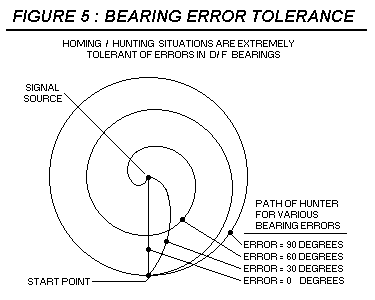HOMING ACCURACY
A display with only 16 LEDís might seem insufficient, but it is completely
adequate for the intended purpose. ( see figure ) In situations where an instrument
is used to "home in" on a signal, tolerable errors can be very large, indeed. If a
hunter follows directions from a D/F with an error of exactly 90 degrees, the D/F
will lead the hunter "around" the signal source, ( endlessly ) in a perfect circle.

If the errors are greater than 90 degrees, the hunter will slowly "spiral out", and
actually travel away from the source. If the errors are less than 90 degrees, the
D/F will direct the hunter to "spiral in", towards the source. Therefore, any display
which can indicate the signal direction with an accuracy and resolution of less
than 90 degrees error will ( eventually ) lead to success. If the errors are
"reasonable" ( less than 30 degrees ) the hunter will merely travel along a
somewhat "curved" path to reach the source, and may not even be aware that
errors exist.
Still, this behavior is based on the assumption that the signal is continuously
available, ( and continuously observed ) which will probably be true for "accidental" hunts, ( stuck mike PTT buttons )
but will rarely be true for "staged" T - hunts.
A Doppler is NOT a "panacea"... for simple (i.e. "accidental") hunts, it will probably be
adequate most of the time, but serious, staged ("cut-throat") hunts will always require
supplemental equipment... signal strength indicators and small/portable Yagis/directional
antennas are ALWAYS part of the technical "repetoir" of a serious D/F hunter.
PROTOTYPE FIELD TESTS
Initial field tests of this D/F unit employed the most rudimentary possible version,
and results were fairly good. Effective range under realistic conditions was about
1 mile. Tests were done at 146.94 MHz. The D/F employed ordinary 1N914
antenna diodes and 470 ohm resistors to drive them. ( instead of more efficient
RF chokes ) The antennas were shortened to 1/8 wavelength, ( about 9 inches at
2 meters ) and antenna radius was reduced to 12 inches, on a 3 foot metal
ground plane.
The D/F receiver was an old 2 - meter Yaesu unit, and the transmitter was a
handheld unit running about 3 Watts with a rubber duck antenna, operated
outside the ( hidden T ) vehicle. ( pedestrian operation ) There were no
extraordinary efforts to either "hide" or "display" the transmitter.
Terrain was fairly flat, in a suburban area ( single story, residential buildings )
Furthermore, the hunter worked alone, and had no previous experience in any
transmitter hunts. No supplemental information was employed. ( such as "hints",
signal strength readings, etc. ) Four hunts were conducted, and each ended
successfully in a period of about 15 minutes. The transmitter was keyed ( more or less )
continuously, to expedite the hunts. This allowed all 4 hunts to be completed in about
2.5 hours, including D/F installation, "training", and D/F removal when completed.
Evidence suggested that range would be much greater if the D/F was situated at a prominent
location, such as a freeway overpass or a small hill... not surprising, really...A second set of
hunts ( to explore this further ) had to be aborted prematurely when a battery in my HT died,
but results obtained up to that point confirmed the hypothesis... I was situated at a point where
I had a clear view of the surrounding terrain in two direction for a distance of about 5 miles
( to the north ) and about 10 miles to the south. Tests to the north were successful to a range
of about 4 miles, when the battery died. The transmitter was running about 10 watts, into a 5/8 wave
vertical on a vehicle rooftop. During portions of this test, the vehicle was sometimes obscured
behind ( local ) hills, and the D/F then indicated a direction to a coastal mountain range, which was
the most likely source of reflected signals.
Again, these tests used the most rudimentary version of the D/F... ordinary signal diodes ( 1N914 )
and 470 ohm resistors for the antenna unit, instead of the more efficient Shottky or PIN diodes
and 100 uH RF chokes. The antennas were ( untuned / unresonant ) 8 inch whips. ( not bad, all
things considered )
ADMONISHMENTS
Don't get any ideas about installing this thing at a repeater location... the most malicious
thing anyone can do at a repeater site is install an efficient antenna and then connect it
to a diode... which is exactly what the Doppler antenna represents. ( can you say "intermod"?)
ACKNOWLEDGEMENTS / THANKS
Many thanks to :
Jeff Fuller for his assistance and co-operation in initial tests.
Marv Johnston for his encouragement in this endeavor.
[HOME PAGE]
[NEXT PAGE]

